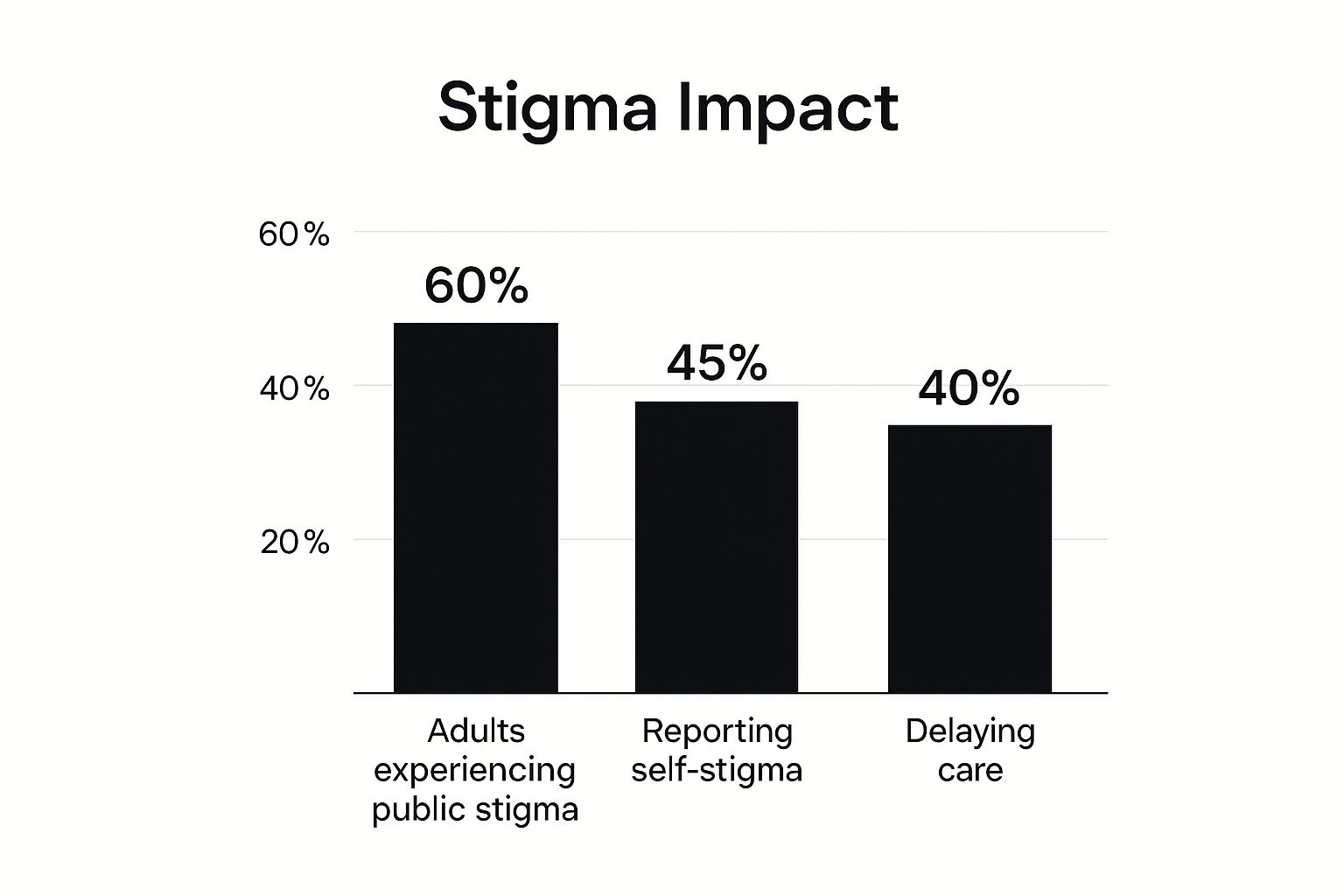
How to Reduce Mental Health Stigma: Effective Strategies
Share
The simplest way to start chipping away at mental health stigma is to talk about it. It’s about normalising conversations, choosing our words with care, and gently but firmly challenging misconceptions wherever we find them. Addressing mental health is critically important; when we treat it with the same weight and understanding as we do physical health, we help build a culture where reaching out for support is seen for what it is: a sign of strength.
Disclaimer: Please remember, I am not a mental health professional. This guide is for informational purposes only. If you are worried about your mental health or that of someone else, it is essential to seek help from a doctor or a qualified healthcare provider.
Understanding the Impact of Mental Health Stigma
Mental health stigma is still a huge, damaging barrier in the UK. It stops so many people—adults and children alike—from getting the help they desperately need. It’s a two-headed monster: there’s the public stigma, which is all the prejudice and discrimination from society, and then there's self-stigma, which is the shame people turn inward on themselves.
This isn't just theory; it has real, painful consequences. Think of a teenager who’s too ashamed to tell their parents they feel constantly flat, or a colleague who passes on a promotion because they're terrified their anxiety will be seen as a weakness. These aren't just hypotheticals. They happen every day, and they show exactly why we need to tackle this head-on.
The silence around mental health is especially toxic for young people. Stigma robs them of the chance for early help, which we know can completely change the course of their lives. With a record 1.4 million children and young people seeking mental health support last year, it's never been more urgent to create safe, supportive spaces for them to talk.

As you can see, it’s not just about what others think. The internal struggle with shame is a massive factor that stops people from taking that first step towards getting help.
The Pervasive Nature of Shame
We’ve made progress, but old attitudes die hard. A recent survey revealed that 51% of UK adults still feel there's a lot of shame attached to mental health conditions. That feeling doesn't just come from the outside—a staggering 56% of people with a mental health problem report feeling ashamed themselves. This shows just how deep self-stigma can run.
We can change this. By encouraging open, honest dialogue and challenging outdated beliefs, we can build a society where mental health is discussed with the same compassion we give to physical health. That change starts with us, in our everyday conversations.
To really get a handle on this, we need to focus our efforts. Here’s a quick look at the core strategies we’ll be exploring to effectively challenge stigma from all angles.
Three Pillars of Reducing Mental Health Stigma
| Strategy Pillar | What It Means in Practice | Why It Matters |
|---|---|---|
| Normalise Conversation | Talking openly about mental health in everyday life, just like you would a cold or a broken arm. | It makes the topic less taboo and shows people they aren't alone, encouraging them to speak up sooner. |
| Educate & Inform | Sharing accurate information and personal stories to replace myths and stereotypes with facts and empathy. | Knowledge dispels fear and misunderstanding, which are the main fuels for stigma. |
| Advocate & Support | Actively standing up against discrimination and creating safe, supportive environments at home, school, and work. | It creates a culture of acceptance where people feel safe and valued, regardless of their mental health. |
Each of these pillars is a powerful tool in its own right, but together, they create a comprehensive approach to dismantling stigma for good.
Getting involved in national events like Mental Health Awareness Week is also a fantastic way to contribute to the wider conversation. In this guide, we'll dive into practical, actionable advice you can use to make a real difference in your own family, community, and workplace.
Creating Safe Spaces at Home and in Schools

If we're serious about tackling mental health stigma, we have to start where our children spend most of their time: at home and at school. This is where we lay the groundwork. We need to build environments where young people feel safe enough to be vulnerable, knowing they'll be seen and heard.
With one in five children and young people in England aged 8 to 25 having a probable mental health condition in 2023, this isn't just a nice-to-have; it's essential. This figure shows a significant rise, highlighting the urgent need for support.
A "safe space" isn't just about four walls and a roof. It’s about emotional security. It’s a home where a teenager can admit, "I feel really low today," without being told to just cheer up. It's a classroom where a child learns that getting butterflies before a test is something lots of people experience.
This kind of change doesn't happen overnight. It’s built on small, consistent actions from parents and teachers—being proactive in nurturing a child's emotional world, not just reacting when things go wrong.
Fostering Open Dialogue at Home
The thought of starting a conversation about mental health with your child can feel a bit heavy. But it doesn't have to be a big, formal sit-down. In my experience, the best chats often pop up unexpectedly—during a drive to football practice, while making tea, or at bedtime.
The trick is to lead with gentle curiosity, not direct questioning. Asking "What's wrong?" can sometimes make a child clam up. A softer, more observant approach usually works much better.
Here are a few practical examples of phrases you could use:
- "You seem a bit quieter than usual. Just wanted you to know I'm here for a chat if you fancy it."
- "That situation at school sounded pretty full-on. How are you feeling about it all now?"
- "You know, it's okay to feel sad or worried. I get like that too sometimes."
When they do start talking, the most important thing you can do is listen. And I mean really listen. Put your phone down, make eye contact, and just hear them out without immediately trying to solve the problem. Sometimes, simply saying, "That sounds incredibly tough," is more powerful than any piece of advice.
When you build this kind of trust, you're opening a line of communication that will stay open when bigger challenges come along. You're showing them their feelings matter and that asking for help is a sign of strength, not weakness.
Cultivating Wellbeing in Schools
Schools are on the front line of this battle. They have an enormous influence on how children view mental health. When wellbeing is woven into the fabric of the school day, emotional literacy becomes just as fundamental as maths or English. This takes the strangeness out of the topic and gives children the words they need to talk about what’s going on inside.
A lot of schools are now running peer support programmes, which are fantastic. Older students get trained to listen and offer a friendly ear to the younger ones. It’s a brilliant system because it gives struggling pupils an approachable first point of contact and also empowers the mentors, fostering a much kinder, more empathetic school culture.
Mental health books are another brilliant tool for getting these conversations started. Stories with characters who are figuring out their own big feelings can help children make sense of their own emotions and see the world from someone else's perspective.
Recommended Reads to Start the Conversation
- For Younger Children: A book like The Colour Monster by Anna Llenas is a wonderful, visual way to help little ones put a name to their feelings.
- For Older Children: The Boy, the Mole, the Fox and the Horse by Charlie Mackesy is full of gentle, profound wisdom about friendship, being kind to yourself, and having the courage to ask for help.
- For Teenagers: For opening up conversations about more complex issues like depression and anxiety, a novel like The Perks of Being a Wallflower by Stephen Chbosky can provide a relatable and safe entry point.
Building A Mentally Healthy Workplace Culture

Stigma around mental health doesn’t vanish at the school gates—it follows us into staff rooms and meeting halls. In the UK, the cost of poor mental health on businesses is estimated to be up to £56 billion a year, primarily through presenteeism, absenteeism and staff turnover. Yet behind those figures lie real people grappling with stress, anxiety or burnout.
A workplace where someone can share feeling overwhelmed without fearing career damage is more than a moral win—it’s a strategic advantage. When mental wellbeing is treated on par with physical safety, trust flourishes and performance soars.
Practical Steps For A Supportive Workplace
Open conversations set the tone. When leaders share their own challenges or check in regularly, it breaks down invisible barriers. Simple actions create lasting change:
- A manager asking, "How are you getting on with your workload this week?" can open a door for someone to admit they're struggling.
- Introduce peer-to-peer support circles where colleagues swap coping tips over a cup of tea.
- Offer flexible hours or remote-working options, trusting staff to balance work and therapy appointments without having to give a reason.
“Are you snowed under right now? Anything I can do to help?”
A short, genuine question can be more powerful than a formal referral. It shows you care without overstepping.
To build confidence in those moments, champion mental health first aid training. Staff learn how to spot early warning signs, provide supportive listening and guide peers towards professional help.
Tackling The ‘Always-On’ Culture
The relentless ping of emails and chats blurs boundaries between work and personal time. That 24/7 mindset leads to a low-grade, constant stress that eats away at resilience.
Setting clear digital boundaries helps safeguard recovery time:
- Set Core Hours: Define firm start and finish times, and stick to them. For example, have a policy against sending non-urgent emails after 6 pm.
- Lead By Example: Managers pause after hours—no late-night emails or weekend pings.
- Encourage ‘Logging Off’: Promote proper lunch breaks away from screens and encourage full use of annual leave.
By acknowledging modern pressures and valuing employees as whole people, organisations build a more resilient, engaged and productive team.
Challenging Stigma with Your Words and Actions
How we talk about mental health really matters. The words we choose can either put up walls of shame or build bridges of understanding. It's often the small, everyday shifts in our language and actions that become the most powerful tools for dismantling stigma and creating a kinder, more supportive community for everyone.
This starts with being more mindful of our language. A simple but profound change is to start using person-first language. Instead of saying someone is 'a bipolar person', try 'a person living with bipolar disorder'. See the difference? This small tweak separates the individual from their diagnosis, reminding everyone that they are a whole person, not just a condition. If you want to dive deeper into having these conversations, our guide on how to talk about mental health is a great place to start.
Using Language That Heals, Not Hurts
Think about how often we hear clinical terms tossed around casually. Describing a tidy desk as 'so OCD' or calling a surprising moment 'psychotic' might seem harmless, but it seriously trivialises the reality of these complex conditions. These aren't just quirky adjectives; they are real diagnoses that people struggle with every single day.
You can gently challenge this without making a big scene. A quiet word can make a big impact. Try saying something like, "I get what you mean, but for people who actually have OCD, it can be a really debilitating condition." It's an approach that educates rather than shames, helping people realise the weight their words can carry.
A key part of challenging stigma is understanding and applying trauma-informed care principles, which helps to foster a safer, more compassionate environment for anyone who might be struggling.
Showing Support Through Action
Of course, it’s not just about what we say—it's also about what we do. Our actions can send a powerful and clear message of support.
Something as simple as wearing mental health apparel, like a hoodie or t-shirt with a positive message, can be a walking conversation starter. It’s a quiet signal to others that you’re a safe person to talk to, and it helps to bring mental health out into the open, making it a normal part of life.
Thankfully, public attitudes in the UK are shifting. Since 2016, there has been a 71% increase in people reaching out to mental health services. This tells us that more people are feeling able to ask for help, which is a massive step forward. Our collective actions, big and small, are helping to build that momentum.
Remember: Every conversation you start, every stereotype you challenge, and every act of support you show contributes to a wider culture of acceptance. Your daily choices have the power to create a ripple effect of positive change.
Prioritising Your Own Wellbeing to Help Others

Before we can effectively support others and challenge stigma, we have to look after ourselves. It’s the classic aeroplane safety rule: fit your own oxygen mask before helping anyone else. Looking after your own mental health isn’t selfish; it’s the bedrock that gives you the resilience and energy to be there for those who rely on you.
When we make self-care a visible part of our lives, we show others—especially children—that it's not just okay, but necessary, to pause, rest, and look after our mental peace. This simple act of modelling behaviour is a quiet but powerful way to dismantle stigma within your own family.
Simple Relaxation Tips for a Busy Life
You don’t need an expensive retreat to recharge. It’s the small, consistent habits woven into your day-to-day life that really make a difference.
-
Try the 4-7-8 Breathing Technique: It couldn't be simpler. Breathe in through your nose for four seconds, hold for seven, then breathe out slowly through your mouth for eight. It’s a fantastic little circuit-breaker when stress starts to build.
-
Have a Mindful Moment: Just take a single minute to ground yourself in your senses. What are five things you can see, four you can touch, three you can hear, two you can smell, and one you can taste? This technique pulls you into the present and away from spiralling thoughts.
-
Get into Nature: Even a quick walk in the local park or ten minutes in the garden can lower stress hormones. The power of the outdoors to restore our calm is well-documented, offering a much-needed break from screens and the pressures of social media's impact on mental health, which often creates comparison and anxiety.
With mental health conditions on the rise in England, especially for young adults, building these coping skills has never been more vital. The latest figures show that one in four 17 to 19-year-olds had a probable mental health disorder in 2022. You can read the full research on these rising figures to understand why breaking down stigma is so crucial for helping people access treatment.
Recommended Mental Health Books for Deeper Insight
Books can be a source of both comfort and knowledge, offering fresh perspectives and practical ways to manage your wellbeing. They create a quiet space for you to reflect and learn more about your own mental health journey.
Reading about the experiences of others can be incredibly validating. It’s a powerful reminder that you are not alone in your struggles and that there are countless paths towards healing and understanding.
Here are a few books that offer some truly valuable insights:
- Reasons to Stay Alive by Matt Haig: A raw, hopeful, and often funny look at living with depression.
- Lost Connections by Johann Hari: This book explores the deeper societal roots of depression and anxiety, and what we can do to find our way back to connection.
- The Body Keeps the Score by Bessel van der Kolk: A profound read on how trauma reshapes the body and mind, offering paths to recovery.
Your Stigma-Busting Questions, Answered
It’s completely normal to have questions when you’re trying to navigate conversations about mental health. It can feel like walking on eggshells sometimes. Let's tackle some of the most common queries with straightforward, practical advice to help you feel more confident.
How Can I Support a Friend Who Won't Seek Help Due to Stigma?
The most powerful thing you can do is listen. Really listen, without jumping in to fix things. Create a safe space where they know their feelings are valid, and gently remind them that reaching for help is a sign of immense strength, not a weakness.
Sometimes practical support speaks volumes. You could offer to help them look up local therapists or community resources, or even offer to go with them to their first GP appointment. Normalising it helps, too. Mentioning that millions of people see therapists or take medication can chip away at the feeling of being alone. The goal isn't to push them into action, but to be a steady, caring presence. Just knowing you’re in their corner can make all the difference.
What Can Our Company Do to Reduce Stigma on a Small Budget?
You don't need a huge budget to make a real impact. In fact, some of the most effective actions are free. A fantastic starting point is getting senior leaders to speak openly about their own experiences with stress, burnout, or anxiety. When leadership models this vulnerability, it sends a powerful message that it’s okay not to be okay.
The cost of poor mental health to UK businesses is significant, often stemming from lost productivity and absenteeism. Fostering a supportive culture is not just an ethical choice; it's a sound investment in your team's wellbeing and the company's success.
Here are a few simple ideas that cost next to nothing:
- Share resources: Start a simple internal newsletter or a dedicated chat channel where people can share wellbeing tips, articles, and links to free resources like Mind or the Samaritans.
- Protect downtime: Introduce protected lunch breaks where no meetings can be booked. This gives people genuine time to recharge.
- Start conversations: Host informal (and optional) "coffee and chat" sessions focused on topics like managing stress or avoiding burnout.
It’s all about creating a culture of psychological safety, which is built on intention, not a hefty budget.
How Do I Counteract Negative Stereotypes My Child Sees Online?
The best approach is to tackle it head-on. Don't shy away from it. Ask them what they saw and, crucially, how it made them feel. This opens the door for a powerful teachable moment. You can explain that mental health conditions are illnesses, just like asthma or diabetes—they are not character flaws or something to be ashamed of. Given the powerful impact of social media, arming your children with facts is one of your best defences.
Point them towards reliable sources like YoungMinds or the NHS. You could watch a documentary or read a book together that portrays mental health challenges accurately and with compassion. Above all, model empathy in your own reactions and encourage them to think critically about what they see online. Teaching them to question stereotypes is a skill that will last a lifetime.
I Feel Ashamed of My Own Mental Health. How Can I Overcome Self-Stigma?
This is a tough one, and it takes time, so be kind to yourself. Overcoming self-stigma is really a journey in self-compassion. A good first step is to learn as much as you can about your condition from credible sources. Understanding the science behind it helps reframe it as a medical issue, not a personal failing. It helps you separate who you are from the diagnosis you have.
Finding a community can be incredibly healing. Peer support groups, whether online or in person, connect you with others who just get it. Hearing their stories makes you realise you aren't alone in these feelings.
It's also vital to start challenging that critical inner voice. When a negative thought about yourself pops up, gently question it. Ask yourself, "Is that really true? Would I say that to a friend?" Working with a therapist can give you brilliant strategies for rewiring these ingrained thought patterns. Remember, you are not your illness, and you deserve the same kindness you would offer to anyone else.
At Little Fish Books, we believe that nurturing emotional wellbeing starts early. Explore our collection of books, activities, and supportive merchandise designed to help children and adults alike understand their feelings and challenge stigma. Visit us at https://thatsokay.co.uk to find resources that spark open, honest conversations.
